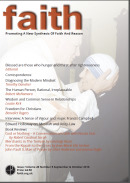Book Reviews: A Journey into Mystery
From the Kippah to the Cross
by Jean-Marie Elie Serbon, Ignatius, 158pp, £10.99. Available via Gracewing.
Reviewed by John Walsh
I have a problem with conversion stories. I have read hundreds of them and enjoyed the stories of the journeys and paths people take to find meaning and reality. The problems I have are twofold. The first problem is that being a bit of an inveterate researcher I tend to follow up leads and further mentions of people who convert. It has always surprised and in some cases shocked me to find out afterwards that the person concerned rejected the destination he or she found and entered another way (in some cases several paths). Was the original story true? What was left out? If things were so clear and certain, why the volte face?
The second reason is that learning more about psychology has convinced me how inner drives and conflicts push us to search for relief and safety. The works of the eminent Neo-Freudian psychologist Karen Horney on neurosis has been a major influence here. As we are driven by inner drives we are called by the search for meaning. The works of the great Dr Viktor Frankl has been so important in understanding this need for meaning. This does not negate the validity of conversion experiences. It broadens them. No longer can we see them as exercises in logic or a solely cerebral working out of options. Perhaps Newman’s Apologia
Pro Vita Sua stands out so powerfully as it is an attempt to think what was really going on in the great man’s thinking.
A journey by and into mystery
This work by Jean-Marie Elie Sorbin is very valuable as it is - for want of a better word - messy. Seeing one thing and going in another direction. Hints and glimmers of one thing followed by different travels to somewhere else. Perhaps the best way we can understand this is to see conversion as a journey by and into mystery. There is a mystery of conversion where the psychological, spiritual and historical all coalesce (if we can even divide these three into neat categories which I doubt). It is the story of a Jewish boy who discovers Christmas ‘full of warmth’ (p 24). It is the story of the same boy who on seeing a crucifix doesn’t associate it with blood or suffering but rather ‘a divine presence, a very powerful presence who pardoned, reconciled, gave peace and brought me a deep interior sense of wellbeing’ (p.27).
While attending Torah study he also would go to the Sacré Coeur and receive Holy Communion. He would live in Israel and study in rabbinical schools. A series of events and people entered his life, and he made the decision to become a Christian and a Catholic. This is a deep and searching reflection on one’s man’s story and response to what lights he saw.
I would recommend this work as it tells us that the path is often not easy, strewn with things we don’t understand and yet which fill us with a longing that won’t go away. It is well written and offers much for us all to think on. At a time when so many are searching for answers one thing that struck me was Jean-Marie’s meeting with a priest who was so humble. He writes that ‘When someone is so rooted in God and the Church he is not afraid to listen to different opinions; he can let himself be enriched by new points of view without losing his grounding in what is essential’ (pp.96-7).
This open, humble and truth-centred approach is perhaps the message and means of the book. How we can be open and yet rooted in our tradition. How we can listen to all in dialogue in a way that our own light become clearer. For in this approach are to be found so many answers, hopes and possibilities.
Notes:
John Walsh has a BA in History and an MA in Theology; he lives in Bradford.






